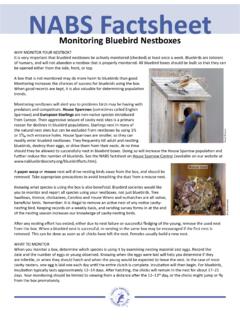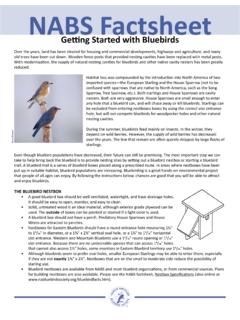Transcription of Frequently Asked Questions (FAQs) - Bluebird
1 Frequently Asked Questions ( faqs )Q: I want to mount a Bluebird box but don t know where to : Bluebirds have quite specific nesting requirements, so it is important to understand that the key to attracting them is placing properly constructed nestboxes in suitable habitat. Bluebirds are insectivorous during the nesting season, feeding mainly on ground-dwelling insects. Ideal Bluebird habitats are open and barren, or short-cut/sparsely grassed areas (so they can see their food) with a few trees nearby for perching. Pesticide- and herbicide-free pastures and meadows, cemeteries, abandoned orchards, hike-and-bike trails, prairie coulees, lightly traveled roadsides, abandoned railroad rights-of way, golf courses, open areas in parks, clearcut or recently burned areas adjacent to forests, and sagebrush flats all provide excellent Bluebird habitat.
2 Bluebirds will also nest on the fringes of towns and cities, especially if they were nesting in those areas prior to Bluebird habitat includes areas that they naturally shun ( , city centers, densely wooded areas, or intensively farmed areas where there is a lack of natural habitat), areas where they are in competition with House Wrens or House Sparrows, or locations where the boxes are at risk of predation or : How do I know if I have the right kind of nestbox for my bluebirds?A: There is no one single perfect, ultimate Bluebird nestbox. Dozens of different nestbox designs are being used with equal success by Bluebird landlords throughout North America. Although styles and designs can vary, all nestboxes should provide the birds with a safe and secure nesting site. The following are some tips for a good Bluebird box; see our Nestbox Recommendations factsheet or web page for more information on nestbox dimensions ( ): The best materials for Bluebird box construction are - to 1-inch wood or exterior grade plywood.
3 Redwood often splits when it dries so it should be avoided in dry areas, and most pine boards will warp over time. Do not use treated lumber or interior grade wood (including OSB board). When possible, use scraps salvaged from construction sites, or where it is available, use environmentally sound, certified lumber from sustainably managed forests. Cardboard, plastic jugs, milk cartons, and large tin cans provide little insulation (especially against heat) so should not be used. Cardboard boxes and milk cartons are also easily accessed by predators. Bluebird boxes made from good quality wood do not need to be painted, but to help them last longer, some Bluebird trail operators coat the outside of boxes with linseed oil, or stain or paint the outside of their boxes with a good quality exterior stain or latex paint.
4 Use a neutral color in northern areas, and a light color in hot areas to reduce overheating. Do not paint the inside of the box. Assemble the box with screws or galvanized nails. Screws are more expensive but make construction easier and make it easier to replace or tighten parts. One panel (top, front, or side) MUST open to allow for monitoring and cleaning. Make sure the panel fits snugly to prevent rain from blowing in the seams. If plywood or smooth boards are used, etch shallow saw kerfs on the inside of the front panel, just below the entrance hole. Although young bluebirds are fairly adept at exiting most boxes, this roughness provides an extra toehold for them. If using hardware cloth, be sure the material is pressed tight against the wood so the birds won t get a toe caught. Perches encourage predators and undesirable House Sparrows.
5 Do not build or purchase a nestbox with a perch. Barbara BairdNABS FactsheetQ: Where and how should I mount my nestbox?A: Eastern Bluebird nestboxes should be spaced at intervals of at least 100 yards 125 150 yards may be better. Mountain and Western Bluebird boxes should be 200 300 yards House Wrens are likely to be a problem, be sure the box is mounted at least 50 200 feet away from a wooded or brushy area. If Tree Swallows or Violet-green Swallows are likely to use the box, try setting out two boxes about 5 15 feet apart so that the bluebirds can use one and the swallows the other. Most bluebirders have found that pairing the boxes will allow both species to nest side by side in relative should be mounted on a smooth metal pole at a height that is convenient for monitoring and maintenance. Bluebirds tolerate a box mounted as high as 15 feet and as low as 3 feet from the ground.
6 However, a box mounted lower than 4 or 5 feet is at greater risk of nestbox should be mounted so the entrance hole faces away from prevailing winds to reduce the amount of rain that might be blown into the box. The box opening should also face away from direct sun exposure. A nearby tree will provide young bluebirds with a place to fly to when they first leave the nest, and shelter from the elements and predators. Boxes mounted along roads should always face parallel with, rather than be perpendicular to, the road so that the birds (especially the fledglings) are more likely to fly along the road ditch, rather than out across the road and into the path of oncoming traffic. For more information, please see the NABS factsheet, Getting Started with Bluebirds (also online at ). Q: OK, I ve got my nestbox mounted.
7 Now what?A: Periodically monitoring your box on a regular basis is very important, as it will enable you to take the necessary steps should problems arise and to collect important scientific information ( , the number of eggs, nestlings, fledglings, etc). Because bluebirds and most other songbirds have a poorly developed sense of smell, they will not abandon their box if you open : Everything seemed to be going fine with my Bluebird family, but today I ve only seen one Bluebird parent at the box. What should I do?A: As long as there is plenty of food, a lone parent can probably take care of the young. Since only the female has a brood patch (a bare patch of abdominal skin), she is solely responsible for incubating the eggs and keeping the young warm (called brooding) during their first week of life. If she is killed during these critical stages, the nest is doomed unless the nestlings can be cared for by a songbird rehabilitator.
8 If the nestlings are older than about seven days, they are sufficiently feathered to stay warm at night, and the male can take care of them (as long as there is adequate food).If you are certain that one parent is missing, check the nest to see what condition the nestlings are in. If they have succumbed, clean the box out. If they are still alive, contact someone with extensive experience with wildlife rehabilitation or bluebirds: To locate a nearby wildlife rehabilitation expert, go online to or call your state wildlife agency or provincial Fish and Wildlife the NABS Hotline (see our website for contact information: ). Contact your area or regional NABS-affiliated Bluebird group (see our website for a list by state or province: ). Q: Something isn t right because I haven t seen either of the parents around for a while.
9 What should I do?A: It is quite possible that something has happened to the parents of your baby bluebirds. The first thing you must do is be 100% sure the nestlings have been abandoned. If possible, watch the box from a distance for one to two hours to see if they are being fed. If neither parent returns, check the box to see if the young are alive. If they are begging vigorously, they are hungry. If they are listless, they are weak and will likely perish if not warmed up and fed. Specialized training and a permit is required to raise wild birds. Do not try to raise them yourself. Instead, contact a wildlife rehabilitation expert as soon as possible. Not all of the nestlings will necessarily survive, but the sooner you get them to a licensed songbird rehabilitator, the better their chances. See the question above for contact some cases, only the male Bluebird returns.
10 A female Bluebird won t abandon her babies voluntarily, so if she disappears it means something happened to her. The male cannot incubate the eggs or keep the nestlings warm for the first few days after hatching, but he may raise the babies by himself if they are old enough to maintain their own body temperature. The male Bluebird is very active in feeding and caring for the nestlings. Also, previous broods have been known to help a single parent to raise a brood. Q: I checked the nestbox and found broken eggs on the ground outside the : House Wrens, which are legally protected and ecologically valuable native birds, will enter a nestbox, poke small holes in the eggs and sometimes toss some or all of the eggs out onto the ground. House Sparrows, which are a non-native pest species, may also be responsible (see the next question for more information).








